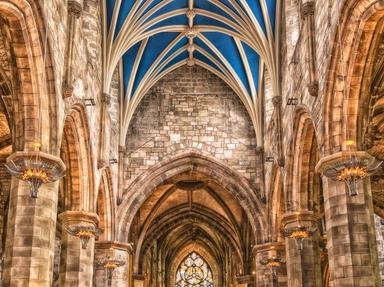Quiz Answer Key and Fun Facts
1. The ruins of this old abbey in a Wiltshire town are only a couple of miles from the far older and more famous ruins that are Stonehenge. One of the Arthurian legends has this as the convent that Guinevere retired to after the death of King Arthur.
2. Although the other buildings have gone, this old abbey chapel is still in regular use as the town's Parish Church. Ellis Peters' fictional Brother Cadfael was a monk here in the time of King Stephen, assisted by his friend Hugh Beringar, the deputy Sheriff of Shropshire.
3. Overlooking the Yorkshire town of the same name, this abbey was the site of a Synod in 664, while the town was the scene of an episode in a book by Bram Stoker, and hosts an annual Goth week.
4. This Cistercian Abbey in Devonshire was rebuilt by a small team of French monks between 1882 and 1937, and is now a working establishment and a tourist attraction famous for its tonic wine and honey.
5. This ruined abbey on the River Wye in Monmouthshire was made famous in a poem by William Wordsworth.
6. Site of the crowning of Edgar (claimed by some to be the first King of all England), and rebuilt by the Normans, this Abbey church still flourishes in a Somerset spa town.
7. This abbey was once the second wealthiest in England, and was built by the monks of Savigny, France on the shores of Morecombe Bay near Barrow where nuclear submarines are now built.
8. Lord Louis Mountbatten was buried in this, his home abbey church, after his assassination by the IRA in Ireland. His ancestral home Broadlands adjoins the Hampshire town where this abbey was built in the 12th Century.
9. This abbey in Suffolk was founded by King Canute to honour the saint whose name is given to the town and abbey.
10. This Berkshire town on the Thames has a Benedictine abbey built in 1121. It was converted to a palace by Henry VIII, which was destroyed in the Civil War.
11. This ancient London abbey is where all English monarchs have been crowned since William the Conqueror in 1066.
12. William the Conqueror vowed that he would build this abbey on the site of the Battle of Hastings, should he beat King Harold. Which he did, of course.
13. This ruined abbey is on the shores of Southampton Water, near the City of Southampton.
14. This Hampshire abbey was founded by an austere group of canons in 1222, in the village where the British Office of National Statistics has its offices.
15. Said to be the most beautiful ruins in England, this abbey with a French name lies within the North York Moors National Park.
Source: Author
davejacobs
This quiz was reviewed by FunTrivia editor
stedman before going online.
Any errors found in FunTrivia content are routinely corrected through our feedback system.
